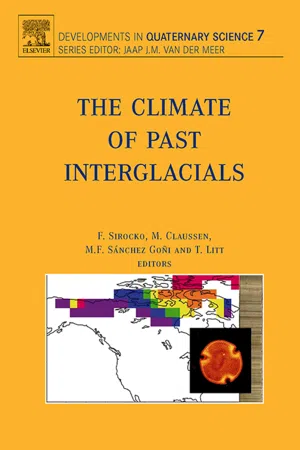
- 638 pages
- English
- PDF
- Available on iOS & Android
The Climate of Past Interglacials
About This Book
Historically, climate fluctuations, such as the Little Ice Age, show that interglacial climate chage in not entirely stable, but responds to even subtle changes in radiative forcing. Through research, it has been made clear that even an abrupt change of climate within years is not just a theoretical possibility but has in fact happened in the prehistoric past. It is therefore clear that in principal it could happen again. Human civilaization has exploded under the mild and relatively stable climatic conditions that have prevailed over the last 11, 000 years. This book focuses on revisiting the past and to study climate and environment in a suite of experiments where boundary conditions are similar but not identical to today so we can learn about the climate-environment system, its sensitivity, thresholds and feedback. The palaeoclimate community holds an important key to scientific information on climate change that provides a basis for appropriate adaptation and mitigation strategies. The authors of this book have taken up this challenge and summarize their results in this special volume. It presents state-of-the-art science on new reconstructions from all spheres of the Earth System and on their synthesis, on methodological advances, and on the current ability of numerical models to simulate low and high frequency changes of climate, environment, and chemical cycling related to interglacials.* Summarizes important information on climate change, providing a basis for appropriate adaptation and mitigation strategies for human civilization* Reports on new reconstuctions on methodological advances, numerical models simulating low and high frequence changes, and chemical cycling related to interglacials* Incorporates palaeovegetaion and numerical modeling of climate and environmental and geochemical parameters to address regional feedback to global change with successful data-models
Frequently asked questions
Information
Table of contents
- Front Cover
- The Climate of Past Interglacials
- Copyright Page
- Table of Contents
- Preface: Climates of Past Interglacials – a PAGES Perspective
- Acknowledgements
- Section 1 Forcing Mechanisms
- Section 2 Methods of Palaeoclimate Reconstruction and Dating
- Section 3 Climate and Vegetation in Europe During MIS 5
- Section 4 Climate, Vegetation and Mammalian Faunas in Europe during Middle Pleistocene Interglacials (MIS 7, 9, 11)
- Section 5 Modelling Past Interglacial Climates
- Section 6 Synthesis
- Index